Workers reports exclusively from Cuba on how the socialist island is coping with the aftermath of two devastating hurricanes…
Exclusive: Hurricanes – Cuba fights back
WORKERS, OCTOBER 2008 ISSUE
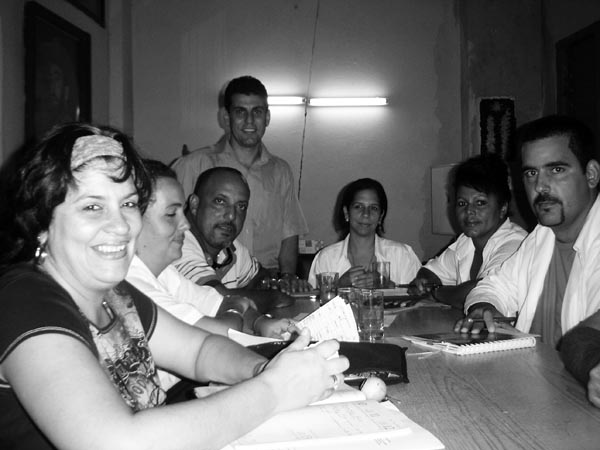
|
|
Pinar del Rio, in the hard-hit west of Cuba, 17 September: the union committee meets to see how to support workers whose houses have been damaged or destroyed.
All Cuba pictures courtesy Dr Maria del Carmen Rodriguez, Cuban Health Workers Union |
Haiti has been hit by at least three hurricanes in close succession. Nearly one thousand have died and hundreds of thousands, if not millions, are homeless with little or no access to food. The southern US was also hit by Hurricanes Fay, Gustav and Ike but at least they all took different courses and weakened overland, yet still more than 50 died in the US during Hurricane Ike. Cuba was hit by the heavy rains of Fay, then Western Cuba and the Isle of Youth were devastated by Gustav, and then Ike simply tore up everything in its way as it roared across the whole length of the island destroying all in its path that hadn’t been destroyed by Gustav in Western Cuba and the Isle of Youth. Miraculously, with 2 million people being evacuated, there were only seven deaths – which, it must be pointed out, directly resulted from the victims not following Civil Defence instructions.
The losses from two back-to-back hurricanes that wiped out housing, crops, electrical lines, schools and hospitals from coast to coast will cost about $5 billion according to Cuban government sources. More than 444,000 homes were damaged with 64,000 destroyed. In the western Pinar del Rio Province alone 137 electricity pylons were lost, as well as 530 transformers and 4,500 smaller electricity poles. In the Isle of Youth every single electricity line is down, 80 per cent of poultry was affected, and 4,355 tons of food in warehouses and stores were lost. Fidel Castro, commenting on Hurricane Gustav said that the Isle of Youth, after the hurricane, looked as if had been subjected to a nuclear attack. That’s the measure of how bad it was.
In Eastern Cuba, as a result of Hurricane Ike, 80,000 acres of bananas were lost and 25,000 acres of other products. 40,000 tons of sugar has to be reprocessed as it was soaked and 1.2 million acres of sugar cane are under flood water. More than half a million chickens died and more than 2,500 schools are partly or totally destroyed.
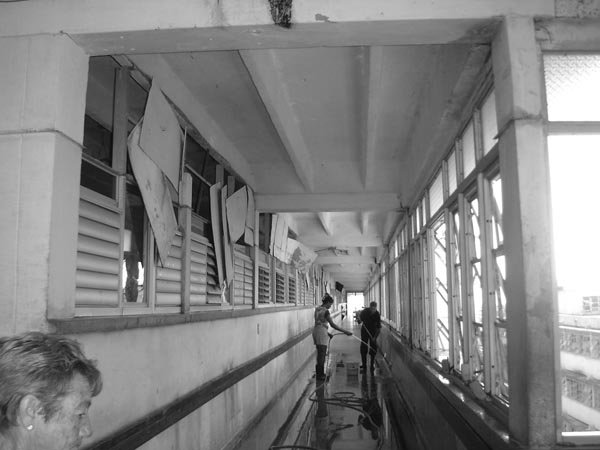
|
| Clean up in the San Cristobal Hospital, Pinar del Rio, where 26 hospitals were badly damaged. |
The Deputy Director of Havana City Council, Osmany Castro Ruz, told Workers that there had been no new build of municipal housing for 15 years because of the Special Period, following the collapse of the Soviet Union and the intensification of the US blockade, when the Cuban economy went into freefall. Now, with economic recovery and an end of the Special Period, this has been the first year of building new municipal housing. Hurricane Ike damaged or destroyed all of the new construction.
Speaking to Workers after a visit to Western Cuban Province of Pinar del Rio, Cuban Health Workers Union (SNTS) General Secretary Maria del Carmen Rodriguez said that 314 medical facilities had been badly damaged in that area, including 26 hospitals, 18 clinics and 191 doctors’ consultation offices.
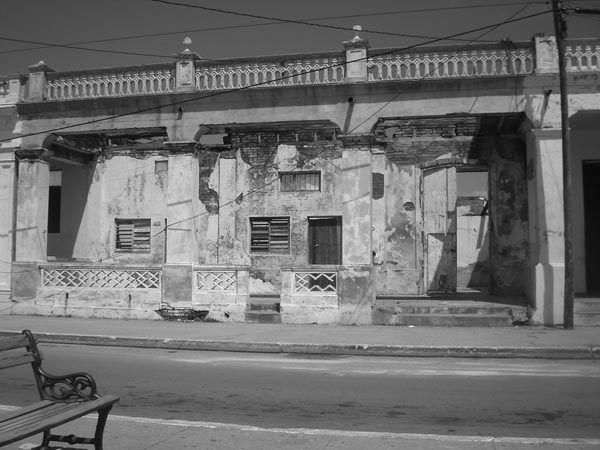
|
| Devastated homes in Los Palacio, Pinar del Rio |
Dr Rodriguez also said that the renowned Henrique Cabrero Hospital in Havana City had been almost destroyed, but that they were still providing care for the patients although some wards had to be moved completely.
Workers asked the SNTS General Secretary how the Cuban Medical Brigade in Haiti had fared during Hurricanes Fay, Gustav and Ike that had killed so many Haitians and destroyed most of the country, particularly around Gonaives. Workers exclusively reported from Gonaives on the Cuban Medical Brigade in Haiti in February 2004 describing them as heroes because of the lives they had saved in such a poor and dangerous country. She said “As you know, Gonaives is still flooded. The Cuban doctors moved their patients from the wards to the roofs of the medical facilities. They then dived into the flood water and swam into the medical buildings to salvage whatever they could, especially food. They then continued to care for their patients on the roofs. There have been no Cuban casualties in Haiti.” True heroes still.
“Our priority has always been to save human lives,” she told Workers.
So how does Cuba save lives during these terrible calamities? Cuba’s values mean that they put the saving of human life above all considerations – human life is sacred. This is at the heart of their planning. They have experienced hurricanes every year and know that they can’t stop them, so they have to manage the effects of them. They refer to them as attacks, hurricane attacks, and deal with them as such.
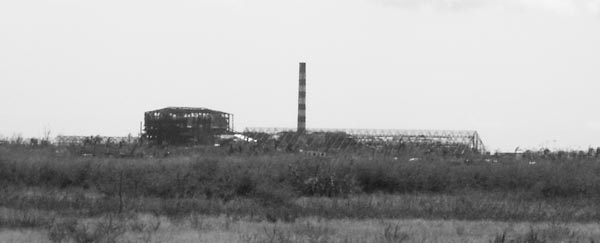
|
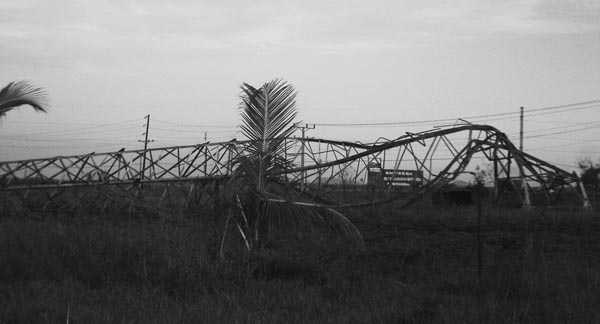
|
| Hurricane-hit infrastructure in Pinar del Rio: a wrecked power station (above) and (below) one of 134 flattened pylons. |
They receive regular information on potential storms from the Institute of Meteorology, which tracks the hurricanes, even when they are first formed as depressions over the Cape Verde Islands as Fay, Gustav, Ike and later Josephine were. A possible route through the Caribbean and in particular, through Cuba, is plotted with the Civil Defence Authority identifying possible dangers such as weak structures, flood plains, and identifying vulnerable people, livestock and assets. The Civil Defence Authority then prepares a plan based on this information.
It then issues its plan as an instruction to the people, state institutions and mass organisations such as the Committees for the Defence of the Revolution (CDRs), Trade Unions and the Federation of Cuban Women. The local CDRs would have already identified at-risk people in their neighbourhood, e.g. the sick and disabled, those living in weak structures etc.
Strategy
The plan will contain an evacuation strategy and the Ministry of Transport will be told, or rather instructed, how many buses and trucks will be needed, where they should be stationed and who should be evacuated to where. The evacuation locations may be in different areas of the country that have been judged less likely to be affected by the coming storm, or alternatively safe public buildings such as schools and other institutions. Locally, the CDRs will evacuate its at-risk people and move them to safer buildings or underground Hurricane Refuges. Hospitals will need to evacuate certain patients to safety and this would need to be done by the Ambulance Service. The mass organisations, who would have previously trained their members in hurricane procedures, would assist with the evacuation, and where necessary, make buildings and assets safe. In the countryside, livestock would also be evacuated to designated safe spots wherever possible.
Dealing with a hurricane
Dr Collazo, the Director of Havana City’s Intensive and Emergency Medical Service, SIUM, told Workers, “For us, the most important and difficult times in dealing with a hurricane are before and after, not so much during. I will receive an order from the Civil Defence Authority instructing SIUM to move vulnerable patients from their wards to safety using our ambulances and to ensure that our accident and emergency facilities are safe. After the hurricane has passed, SIUM will collect the patients and take them to a place where their treatment can continue if their original medical facility has been damaged. During the hurricane, we may have to attend with ambulances to those few who have not followed the instructions to evacuate – putting our crews’ lives at risk.”
Ironically, Cuba has a shortage of both construction and agricultural workers, because in Cuba, every child has the right to free Higher Education. Consequently, few choose to become bricklayers or farmers. Cuba was already trying to rectify this problem and reduce its $2 billion food import bill. Since the hurricanes, 5515 Cubans have volunteered to farm unused land and work brigades can be seen travelling to the affected areas to help with reconstruction.
Food, especially vegetables, is now in short supply and the country has had to use its strategic reserve of food, put aside for war. Cuban Government officials expect serious shortages of food for six months and are taking steps to increase domestic food production to ensure that no one goes hungry. However, Cuba will recover from this because, uniquely, the Cuban working class is in power. This means they can harness the full strength of a working class with its solidarity and humanity to bear down on the effects of this calamity.
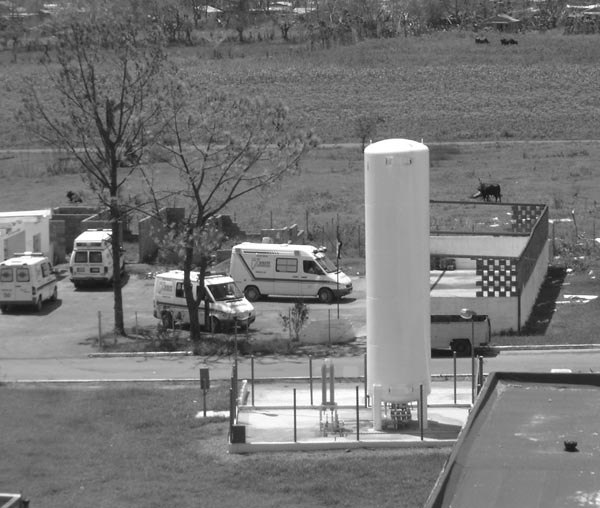
|
| Ambulance station, Pinar del Rio – with the roof blown off. |
Interestingly, the first aid to arrive in Havana was in four giant Antonov cargo planes from Russia. This was followed by aid from Venezuela, Colombia, Mexico, Vietnam, Brazil, China, Dominican Republic etc. While East Timor gave $500,000 of unconditional aid funds, the USA offered $100,000 for aid, minuscule given the scale of the damage, on condition that they send a team to assess it – as if the Cuban Civil Defence Authority was not doing that already. Cuba rejected the offer which was just a very cheap bid to gain access to the country, insisting that the US blockade of Cuba be lifted to allow them to buy steel sheeting for roofing and other essential material.
This was refused by US Secretary of State Condoleeza Rice, showing utter contempt for the hurricane victims. But the combination of humanitarian values and working class organisation will eventually overcome the blockade just as it overcomes hurricanes.